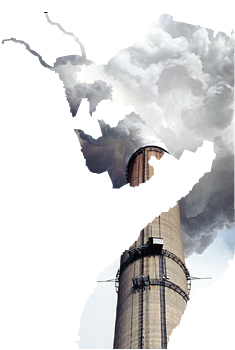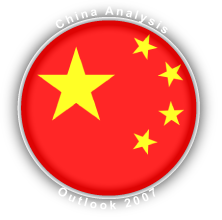Will China’s Rise Lead to an Environmental Catastrophe? summarizes The Economist Chicago debate, examining the environmental fallout of the Chinese economic supernova—sibling rivalry rears its ugly head.
 In 2007, nary an RSS feed or the page of a newspaper (for those still inclined ,^) does not mention China’s exploding impact on the global stage: China is truly an economic supernova, and it is breaking almost any record for development that is laid before it. However, China’s breakneck development is accompanied by grave environmental fallout: for example, as the host of the Beijing 2008 Olympic Games, the city is designing extreme measures to ensure that the air is clean enough for the athletes to breathe. The chief culprit is coal, a key source for China’s insatiable need for electric power, and a resource that the country has in abundance. For key facts on China, I suggest The Economist’s Country Briefing or CSRA’s Emerging Markets category (in depth) or China tag (mentions).
In 2007, nary an RSS feed or the page of a newspaper (for those still inclined ,^) does not mention China’s exploding impact on the global stage: China is truly an economic supernova, and it is breaking almost any record for development that is laid before it. However, China’s breakneck development is accompanied by grave environmental fallout: for example, as the host of the Beijing 2008 Olympic Games, the city is designing extreme measures to ensure that the air is clean enough for the athletes to breathe. The chief culprit is coal, a key source for China’s insatiable need for electric power, and a resource that the country has in abundance. For key facts on China, I suggest The Economist’s Country Briefing or CSRA’s Emerging Markets category (in depth) or China tag (mentions).
The Economist and WBEZ 91.5 FM presented an Oxford-style debate on the effect that China’s rise would have on the environment at Millennium Park’s Harris Theater on 24 October 2007. National Public Radio’s Worldview host, Jerome McDonnell, moderated the session in which two debate teams argued their cases in front of the audience, which then voted on the debate winner. As a baseline, McDonnell polled the several hundred member audience prior to the debate, and we were evenly split and “too close to call.”
- Arguing for the proposition—that China’s rise would produce environmental calamity—were Orville Schell, Director of the Center on U.S.-China Relations at the Asia Society and Barry Weisberg, University of Illinois, Chicago.
- The panelists arguing against the proposition were Vijay Vaitheeswaran, Global Correspondent for The Economist and Kelly Sims Gallagher, Director of the Energy Technology Innovation Project.
- I will report the debate as it happened: debaters’ opening statements are followed by audience questions and the final verdict. To keep you in suspense, I will only disclose the winner after I have reported on the debate, and I’ll wrap with Analysis and Conclusions.
For: Orville Schell: China is already a major environmental disaster
Schell cited a slew of statistics to make the case that an environmental disaster of unprecedented proportion already exists in China:
- China’s economy has been growing around 10% per year for the past several years.
- China’s population is difficult to fathom: it has 1.3 billion people, and its population grows by 10-15 million people per year, despite the one child per family restriction.
- It has 25% of the world’s population on 7% of the world’s arable land.
- Electricity production grows by 20% per year, and 70% of electricity is powered by coal-fired plants. On average, one new plant goes into production each week. Power plant efficiency is 20% less than U.S. efficiency.
- Carbon production increases by 10% annually.
- 10% of cropland is polluted: food is contaminated, and water is replete with pesticides and fertilizers.
- China is seriously overlogging its forests; it now depends on importing hardwoods from other Asian nations, exacerbating their logging.
- China has one fifth of the water of the U.S.; due to its growth in demand for water, the water table is being depleted rapidly. Rainfall is volatile and disturbed: it is experiencing unprecedented drought and flooding in various areas of the country.
 One third of wastewater is untreated, affecting two thirds of households.
One third of wastewater is untreated, affecting two thirds of households.
Against: Vijay Vaitheeswaran: yes, there’s a problem, but we’ve been here before
Vaitheeswaran recently authored The Economist’s Survey on Innovation, and he countered Schell’s statistical barrage by reminding the audience that we live in the 21st century and have new solutions to the problem: do not assume that China will follow western path of the 19th and 20th centuries:
- When India was newly independent from Britain, Gandhi famously said that “We can’t follow” Britain’s model of economic development. (India was different and had to find its own way based on its beliefs, people and resources). China cannot follow the U.S., the quintessential industrial power. It cannot urbanize and motorize as the U.S. did.
- We live in an extraordinary time. One third of humanity lives in misery. China is pulling a major portion of its population out of misery, within one generation. The key challenge is learning how to do that while not doing irrevocable environmental damage.
- Western industrial cities like Pittsburgh, Los Angeles and Chicago endured severe coal-fired air pollution. Dickens chronicled British pollution and squalor; 1952’s London was similar to 2007’s Beijing, and today London has very clean air.
- China’s leaders are aware of the environmental challenge, and they are trying to optimize the environment with economic growth. They have shown that they can get fast results and put programs in place to mitigate environmental damage: for example, Buicks rolling off Chinese assembly lines now have catalytic converters with the same standards as California, which has the most stringent standards in the U.S.
- China will learn from the U.S. and Europe and implement clean cars, fuels and biofuels. The government has shown that it can make changes quickly.
- Do not assume that China will follow its current path: it will innovate and contribute much to the world. Innovation is discontinuous and will surprise. Many intelligent people have made false predictions by entertaining current assumptions that did not hold true in the future: for example, the Club of Rome predicted an cataclysmic population bomb in the 1970s.
For: Barry Weisberg: that’s fine and good, but China is locked into its economic goals and is out of control
Weisberg lived in China in 1971 and has returned many times. He finds the amount of change during that time impressive and appalling from an environmental perspective. He refined the For team’s argument that China was already well down the road to environmental catastrophe:
- 750,000 people already die in China due to environmental causes each year. Seven rivers are dead.
- China has four times the population density (of the U.S.?). Industry never stops; there are no weekends, most factories work around the clock (and pollute).
- Two new power stations come online per week.
- Shanghai has 13 of the world’s top 200 tallest buildings, and most skyscrapers have been built during the past seven years.
- Weisberg described a “pollution complex” of interlocked features that is very difficult to dismantle. China’s top three cities (Beijing, Shanghai, Hong Kong) are megalopolises, and they produce extreme amounts of primary pollutants, and there is extreme interaction among these clusters.
- The Chinese government cannot control the economy, and the economy is driven by external market forces; therefore, the prospect of improvement is slim. China’s urbanization is the most rapid and on the grandest scale of any in human history. The biosphere cannot support this speed and scale of development.
- The government has no legal infrastructure to regulate or control environmental damage. The U.S. must pressure China to make changes more quickly. China will not act unless pressured by the U.S.
Against: Kelly Sims Gallagher: the will to change is already manifest
 Gallagher authored China Shifts Gears, which presents the opportunity to help China develop its auto industry differently than western nations. Her argument picked up on Vaitheeswaran’s: China’s infrastructure is beginning to be built, and the world has the opportunity to help it develop a new model.
Gallagher authored China Shifts Gears, which presents the opportunity to help China develop its auto industry differently than western nations. Her argument picked up on Vaitheeswaran’s: China’s infrastructure is beginning to be built, and the world has the opportunity to help it develop a new model.
- There are certainly major environmental problems in China. 25% of Los Angeles’ particulate pollution is attributable to China, which recently wrested the title of the world’s biggest polluter away from the U.S. , which had held the title since (World War II).
- Many of China’s problems are shared with many other nations around the world. Pollution and, specifically, carbon (greenhouse) emissions are certainly a global problem. Many clean technologies are not used in the U.S., for example.
- There are no incentives to use clean technologies. We must help China to change its public policy and production patterns.
- The key issue is that the will to make changes must emerge in China and in other countries, notably the U.S., which flouts the Kyoto Protocol.
- The Chinese (federal) government is beginning to show the will. There are 1,000 environmentally-focused protests in China each week, and the government is feeling the pressure of its customers, the external market. Moreover, China’s southern neighbors are adding pressure, primarily South Korea. People won’t give up, and the will to change will emerge.
- There have been promising improvements: from 1978 to 2006, there has been a three-fold improvement in fuel efficiency; new cars are more efficient than those in the U.S. The government levies high taxes on large cars and is putting into place incentives to encourage use of renewable energy.
Question and Answer Period
- Can green model cities like Dongtan (see Pop-Up Cities: China Builds a Bright Green Metropolis) have an impact (my question): Gallagher’s assertion that China could follow a different path is appealing and logical. Weisberg reiterated his position that China was locked in. Vaitheeswaran countered that China had incredible opportunities that OECD countries did not—to develop its infrastructure to minimize environmental damage. China and India are not built yet, and much innovation will be introduced.
- Schell: if I were a U.S. presidential candidate, I would go to China to talk about these issues. The federal government officials are already quite enlightened, but the problem is local officials, who are competing and pushing for fast development.
- We must find a way to lick the coal problem. Gallagher stated that the U.S. had to go first and take serious action on its polluting coal-fired plants. China will follow the U.S.’s lead.
 How will China handle growth?
How will China handle growth?
- Schell: no government can remedy; China needs peripheral organizations like an independent media. China has very fragile institutions.
- Vaitheeswaran pointed out that the Soviet block was still suffering from many of the same problems that arose from similar circumstances. He made the interesting point that, in communism, “the commons was lost”: since there were no property rights, there was no accountability or incentive to protect. You need an element of individual accountability.
- Weisberg added that in the U.S., huge lobbies prevent change. China lacks local ways to implement federal mandates. It will take decades to make things happen. Also, no one (anywhere) knows how to manage megalopolises.
- Kelly asserted that China could act decisively, but one problem was enforcement: the Chinese equivalent to the Environmental Protection Agency is staffed with 200 people!
- The West has largely solved the particulate matter problem but not the carbon dioxide problem. There are several problems that are difficult to overcome. Particulate matter is immediate and palpable, and it is therefore easier to convince people to act. The carbon problem is invisible and will manifest relatively far in the future. Debate teams were mostly pessimistic about the carbon problem; they felt that the people, in the form of a grassroots movement, would have to drive the change. There will be meaningful action in the U.S.
- Weisberg made the excellent point that the U.S. (and other rich countries) export the pollution problem to China by driving insatiable demand for its goods. In effect, we export carbon emissions to China. He attributed one fourth of China’s carbon emissions to U.S. exports.
- The issue of public vs. private industry; who is responsible for meeting (environmental) goals? Gallagher refuted the conventional wisdom that the Chinese government acts too slowly. They surprised Chinese and foreign officials by passing stringent auto emission targets. When these passed, the auto manufacturers fell into line. This gave her reason for optimism. Of course, China imports almost all its oil, so economic and political motivations align with environmental to push fuel efficiency. The most severe measures are on heavy vehicles like trucks and SUVs. The average Chinese car is already more efficient that the average U.S. car.
- More on the U.S. role. Schell stated that the U.S. had a stake in helping China. His partner contradicted him, saying that it was dangerous to think that the U.S. could help China; it didn’t even recognize China for 30 years. The Chinese will solve the problem by themselves. They don’t need democracy; they need to balance development with environmental protection.
- There was some discussion around Europe’s system of capping emissions, which involves carbon credits. Gallagher and Vaitheeswaran posited that such a system would not work in China because it requires precise measurements and enforcement. They prescribed a system of taxes, which is far easier to implement. Gallagher predicted that the U.S. would adopt the emissions caps. It has succeeded with sulfur dioxide.
- An audience member who had just returned from living six months in Beijing shared that the sun was rarely visible, even hundreds of miles in any direction from the city. The air is very hard to breathe, and NGOs are very weak and have little support. Government initiatives are messy, such as the Three Gorges Dam.
- Vaitheeswaran suggested that concerned U.S. citizens start pushing for change in their own back yards: coal fired power plants supply 55% of U.S. electricity, and most of them are over 30 years old. They have less than 35% efficiency. There are no real incentives to change, and lobbies have been successful in maintaining the status quo. Further, we can’t expect that China will pay for R&D for environmental solutions. They will buy mature technology that doesn’t cost too much. For example, GE has bet heavily on clean coal technology.
- Vaitheeswaran pointed out that China is open to the world, which brings scrutiny. China is very invested in the global economy. He reminded the audience that the Cleveland River experienced spontaneous combustion in the 1970s, and it is very reasonable today.
 There was widespread agreement that the U.S. had lost “all moral authority” in the world—on many fronts, but on environmental issues in particular. The message that the U.S. government gives—just beat out by China as the biggest polluter—is that the U.S. will go its own way. I think it was either Schell or Weisberg that said, “We are all carbon sinners” (and we must collaborate to solve the carbon problem). The U.S. cannot expect to be listened to unless it leads—by adopting real change on its own emissions policies.
There was widespread agreement that the U.S. had lost “all moral authority” in the world—on many fronts, but on environmental issues in particular. The message that the U.S. government gives—just beat out by China as the biggest polluter—is that the U.S. will go its own way. I think it was either Schell or Weisberg that said, “We are all carbon sinners” (and we must collaborate to solve the carbon problem). The U.S. cannot expect to be listened to unless it leads—by adopting real change on its own emissions policies.- Weisberg stressed that we had to reverse 300 years of wreaking industrial havoc on the environment; he attributed 4/10 premature deaths to pollution worldwide. He concluded by saying that China was a hope; it will be the battleground. It is clearly a master of change. The path will undoubtedly involve clean coal; China will find a way to make coal work because it has so much of it and a high demand for power.
Analysis and Conclusions
- It was a landslide: the audience unequivocally decided that the For team had carried the day. I was one of the few dissenters and remain so.
- There are several reasons why the Against team had a more difficult task. The For team was citing developments that were obvious—now—and everyone agreed that China had severe ecological problems and worrying trends. The reason I believe that China will, long-term, not be an environmental catastrophe is that it will take advantage of emerging technologies and approaches to “bake green development in” to economic development; moreover, emerging technology is disruptive (thank goodness, we want to disrupt these trends) and discontinuous. In other words, it is difficult to build a case for it based on current facts.
- It seems certain that environmental damage will increasingly assume an obvious economic cost, and, once this is understood, people can make rapid and profound changes their behavior to mitigate it. However, many studies suggest that we are reaching a point of no return and that it may be too late to avoid global calamity.
- This U.S. audience was very concerned about environmental issues, notably carbon emissions, and their frustration with the situation was palpable. They were looking for an outlet for their concerns. Moreover, panelists and audience members were vocal in their cynicism regarding (the lack of) U.S. political leadership. At this point, the Bush Administration has caricatured itself into a position that is beyond criticism—due to its abject incompetence. Speakers were even more disheartened by the fact that no presidential candidate was seriously addressing carbon emissions.
- Given the rising awareness of the threat of carbon emissions and the lack of action in the U.S., China is a target for U.S. frustrations. Human nature holds that is is easier to blame someone else than to take accountability yourself. I wonder how many people in the audience drive SUVs.
- A serious part of the U.S.-China dynamic is sibling rivalry that the U.S. feels with respect to China, and this clearly carries over into the debate. There is a desire to maintain the upper hand, to judge China and its aspirations. I could easily imagine French, German and British citizens’ angst at U.S. missteps during the 19th century, when the U.S. was eclipsing Europe. To be most effective, U.S. diplomats, chief executives and scientists must keep this feeling explicit so that it doesn’t color collaboration in a negative way.
- For a U.S. business executive and economist’s point of view on the U.S. position, see Caterpillar CEO Pitches Free Trade Gauntlet to Business Leaders at Executives’ Club.
- The world as we know it is undergoing an unprecedented metamorphosis—into one world. Carbon emissions are a global issue that can only be solved through global collaboration. Unilateral action is decreasingly an option. Paradoxically, the U.S. can lead by giving the most, by, well, leading.
- Panelists and audience had very low expectations of politicians and reached the conclusion that real action would have to be grassroots. I might add that all demographics were represented; this was by no means an activist or fringe-y crowd.
- China (and India) will avoid becoming environmental catastrophes by changing the model of their societies and economies. The For argument will be proven wrong because China can build its cities differently, an idea that struck me when reading the Wired article referenced above. China is currently the factory of the world and will remain so for the forseeable future; it will be an unparalleled industrial economy. However, that also means that, by changing its economic and environmental policies and practices, it can have a major impact on the global situation.
- If the U.S., China and Europe were to get very aggressive with carbon emissions, the global picture could change quite rapidly. In the U.S., the problem may be the most intractable: the country is completely built on the automobile; it has a paltry collection of public transit systems, and its distances are massive. Europe is far less structured on the automobile; as Vaitheeswaran mentioned, China is beginning to build public transit systems aggressively. It doesn’t take a genius to see the need and importance of them. Finally, China has another substantial advantage: it has no oil and is thus incented to build its infrastructure to minimize its dependence on oil. The U.S. built its entire infrastructure on oil and the motorcar because oil was plentiful and cheap during its period of explosive infrastructure growth.
- Longer term, the trend in the Knowledge Economy is that work goes to where people are. In the Industrial Economy, people went to where the work was because it was at a factory that was transforming raw materials into products. They were doing “bits” work, and the Knowledge Economy focuses on “bytes” work. This will serve to centralize pollution production (factories, not cars), which can often be rectified more quickly.
- In the U.S., air pollution and carbon are decentralized in the form of inefficient automobiles. Cutting back on automobile use would have a disruptive effect on the economy since relatively few alternatives exist.
- If the U.S., Japan, Europe and other advanced economies take the lead by acting decisively in their own back yards and by transferring technology to China, India and other emerging economies, the world should be able to diminish its carbon production. The question is, how much time do we have? The devil is always in the details.

Leave a Reply
You must be logged in to post a comment.